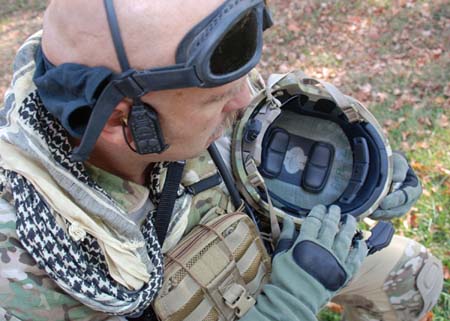 Pararescuemen and medics will be able to determine a soldier’s health status on the battlefield remotely with two small-sized devices that QinetiQ North America has developed in coordination with the Air Force Research Lab’s human effectiveness directorate at Wright-Patterson AFB, Ohio. The Battlefield Automatic Life Status Monitor, or BALSM, consists of two sensors: a wireless unit that measures the amount of oxygen in the blood and estimates heart rate and respiration; and a wireless capsule that, when ingested, measures core body temperature. “The key was to make monitoring devices that were small enough, rugged enough, and able to perform remotely,” said Dianne Popik, AFRL’s program manager. The external sensor is worn against the forehead as part of a headband or integrated into a helmet. Both devices transmit information to computers that the pararescuemen and medics carry. (Wright-Patterson report by Elizabeth Long)
Pararescuemen and medics will be able to determine a soldier’s health status on the battlefield remotely with two small-sized devices that QinetiQ North America has developed in coordination with the Air Force Research Lab’s human effectiveness directorate at Wright-Patterson AFB, Ohio. The Battlefield Automatic Life Status Monitor, or BALSM, consists of two sensors: a wireless unit that measures the amount of oxygen in the blood and estimates heart rate and respiration; and a wireless capsule that, when ingested, measures core body temperature. “The key was to make monitoring devices that were small enough, rugged enough, and able to perform remotely,” said Dianne Popik, AFRL’s program manager. The external sensor is worn against the forehead as part of a headband or integrated into a helmet. Both devices transmit information to computers that the pararescuemen and medics carry. (Wright-Patterson report by Elizabeth Long)
Trainees in Basic Military Training and technical school no longer have the option to try alternate PT drills if they fail an initial assessment, according to a policy change the Air Force made in April. The move is part of a larger shift out of the classroom and into hands-on,…